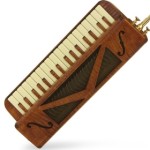Tenor Melodica
Tagged: Tenor
- This topic has 22 replies, 4 voices, and was last updated 8 years, 9 months ago by
 Quetscher.
Quetscher.
-
AuthorPosts
-
July 22, 2015 at 10:07 pm #5668
Auxane
ParticipantHi !
I’m a french jazz pianist studying in the school of Didier Lockwood. I bought a melodica last year, the cheapest, and it looked as a toy! After some research, i discover that melodicas are a real instrument, if you buy the good one. I always have been confuse bye “high” sound of the melodica. Alto and soprano. But i discover that tenor melodicas was existing ! So i looked on the web to find one, and i looked hours, but i find nowhere to buy one ! I make this post to have information about tenor melodicas, a reference, a mark, anything to help me (us) to find TENOR MELODICAS !
Auxane CartignyJuly 23, 2015 at 5:11 am #5669 QuetscherParticipant
QuetscherParticipantHello and welcome Auxane,
although Hammond doesn’t use this term you could call the Hammond 44 a tenor melodica (and the only existing tenor melodica in the world!) because of its range down to c. At the same time it’s an alto melodica reaching g3. And, best of all, it’s a highly professional instrument! Unluckily it’s not the cheapest but the most expensive of all, but according to the reviews in this site it should be worth it.
Greetings, Quetscher
July 23, 2015 at 5:41 am #5670 Melodica-MeParticipant
Melodica-MeParticipantWelcome Auxane, great to have you. As Quetscher states the Hammond has the range you are looking for. The next step would be the Eolina but hard to find and yet 3 times the cost Of the Hammond. The Hammond is well worth the investment and I have not found a better all around melodion than the HP 44 and Hyper. (Personal preference). They really work well for jazz.
Melodica-Me
Monsters of MelodicaJuly 24, 2015 at 1:59 pm #5672 Alan BrintonParticipant
Alan BrintonParticipantIn watching auctions for melodicas, for example on eBay, I occasionally see an alto melodica referred to as a tenor. The seller of a melodica on eBay often is a person who is not a musician and who is not knowledgeable about melodicas.
Melodica Shack, an Internet seller of melodicas, in its buying guide, lists “Tenor” as one of the types of melodicas, but even though the Hammond 44 includes the tenor range, it isn’t, strictly speaking, a tenor melodica, not anymore than a regular piano is a tenor piano.
July 24, 2015 at 4:12 pm #5673 QuetscherParticipant
QuetscherParticipantAlan,
you are certainly right when you say that a regular piano isn’t a tenor piano, it is also a bass piano and an alto piano and a soprano piano, and that’s why you can use a piano at each place in a musical context. But this is NOT possible with a Hammond 44 (which, if you want to be exact, is a tenor PLUS an alto melodica). But no other melodica has that range you would need if for example you wanted to play a Bach choral and needed a tenor voice. So compared to all the other melodicas out there you have only ONE instrument that is a REAL tenor (even the Eolina is more of an alto plus soprano melodica, just like the Vibrandoneon).
Pardon my English, I wish I could explain my thoughts better!
July 24, 2015 at 5:30 pm #5674 Alan BrintonParticipant
Alan BrintonParticipantYour English is fine, Quetsher, and your explanation is very clear. Thanks for the clarification!
July 24, 2015 at 6:16 pm #5676 QuetscherParticipant
QuetscherParticipantYou make my day…
July 24, 2015 at 9:00 pm #5680 Melodica-MeParticipant
Melodica-MeParticipantQuetscher, Alan, this weekend I will check on the range between the Vibrandoneon (low register and high register) the Eolina and the Hammond 44. Based on the range below they should all be in the Tenor range
Piano-Vocal tenor range
Bass: C2-E4, Baritone: F2-G4, Tenor: B3-C5, Alto: E3-E5, Mezzo: G4-G6, Soprano: C4-C6Melodica-Me
July 25, 2015 at 5:11 am #5682 QuetscherParticipant
QuetscherParticipantMelodica-Me,
there must be something wrong about the ranges: I’m quite sure it must be B2(C3)-C5 for tenors and G3-G5 for mezzos.
Quetscher
July 25, 2015 at 5:58 am #5683 Melodica-MeParticipant
Melodica-MeParticipantQuetscher, B2 would take you into baritone. Mezzo-soprano G4-G6?
Melodica-MeJuly 25, 2015 at 6:05 am #5684 Melodica-MeParticipant
Melodica-MeParticipantQuetscher, so here are my reading with my chromatic tuner.
If the tenor range is from B3-C5
Eolina range
E3-C7
Tenor, alto, mezzo-soprano-soprano, soprano
Vibrandoneon
G3-E6 low register
Tenor, alto
G4-E7 high registe
Mezzo-soprano, soprano
Hammond 44/ Hyper
C3-G6
Tenor, alto, mezzo-soprano, soprano
Hammond soprano
F5-G7
Above soprano range “piccolo range”
Hohner Professional/Solist/Piano
F3-E6
Tenor, Alto
Clavietta
G3- E6
Tenor, alto, mezzo-soprano, soprano
Melodica-MeJuly 25, 2015 at 6:29 am #5685 Melodica-MeParticipant
Melodica-MeParticipantQuetscher, when you refer to the b2 range that is know as an Extream tenor which is not a normal range. C3 to C5 is considered the “normal” range for a tenor. Is it different in Europe.
Melodica-MeJuly 25, 2015 at 1:35 pm #5691 Alan BrintonParticipantJuly 25, 2015 at 6:18 pm #5692
Alan BrintonParticipantJuly 25, 2015 at 6:18 pm #5692 Alan BrintonParticipant
Alan BrintonParticipantRanges of different instruments are shown in this chart: http://www.donbarbersound.com/assets/files/Musical%20Instrument%20Range%20Chart.pdf
I have been of the opinion for some time that there is a “sweet range” of notes that sound the best and play most comfortably on the melodica. This can be said, I think, roughly of melodicas in general, but it is also to some extent relative to the model and to the individual player. It seems to some extent to be more or less an issue depending on the skill level of the player. Among current standard sized melodicas, a 32 key alto most closely approximates the sweet range for me, which is probably one of the reasons that I prefer, say, the Yamaha P-32D to the Yamaha P-37D: those additional five keys take me beyond my melodica sweet range, which is not an issue for the more skillful players on this site, who are more comfortable than I am playing those additional five notes.
Actually, the whole idea of a “sweet range” on the melodica may have no meaningful application for most Melodica World regulars. Choices by professionals about which melodica range to use will depend upon other considerations. But I think “sweet range” is a useful concept in relation to beginning-intermediate players. For those players, the concept may be useful in choosing a melodica, for example in choosing an alto over a soprano or a 32 key model over a 37 key model.
But there are also implications in relation to melodica design. Thinking now in terms of the low end, there should be such a thing as a tenor melodica, namely one that starts at B3. It will be a “true” tenor melodica if it has 25-27 keys. A 32 key melodica that begins on B3 also should, I think, be referred to as a tenor melodica. I would love to have a 25-27 key tenor melodica and a 32 key tenor melodica. Actually, I’d also love to have a 37 key tenor melodica, if by that we mean one that starts at B3.
So I think a tenor range is a possible innovation for Daren’s ideal melodica (or a tenor option or cartridge, ala the Suzuki MA-32). Let’s hope that if Jon Batiste has a major melodica company as a sponsor, it will be Suzuki. Suzuki has been the most experimental of the Big Three, historically speaking, has produced the greatest variety of melodicas, and has consistently maintained high levels of quality construction in its high end models. Suzukis have been what Jon Batiste plays. Jon, are you out there? I’d like to send you an MA-32, the best kept secret of Suzuki Melodions, if you don’t already have one.
July 25, 2015 at 9:05 pm #5693 -
AuthorPosts
- You must be logged in to reply to this topic.

